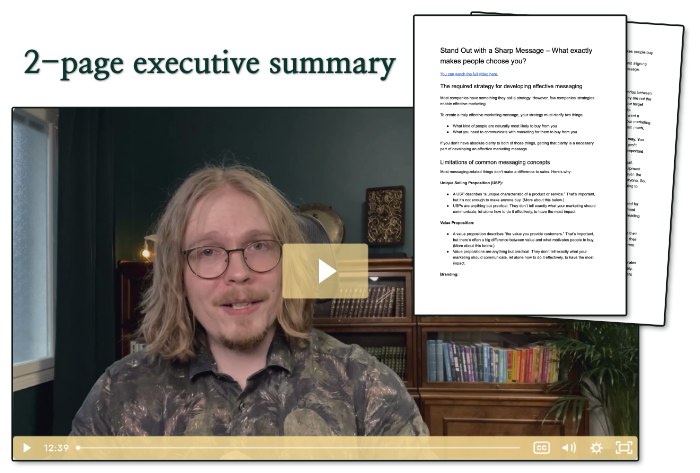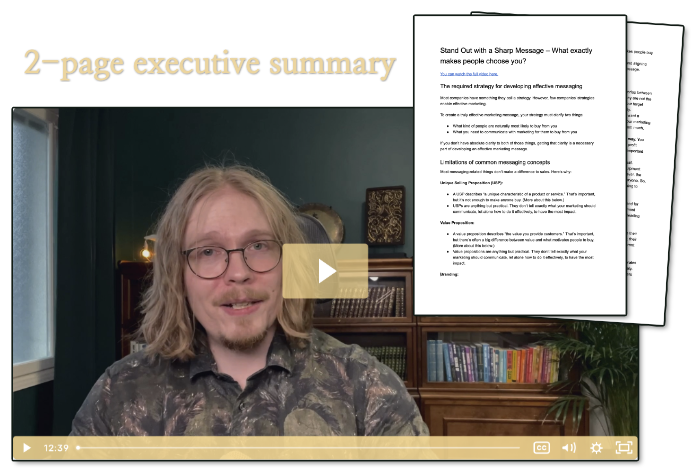Most B-to-B companies have ineffective websites. That is, even when the right people visit their website, they don’t get many leads. Or when people are thinking about buying, the website doesn’t push the sale forward, but rather hinders it.
Almost every company has done multiple website redesign projects. Very, very few of those companies have seen a meaningful improvement to their sales thanks to those projects.
There are many common issues: vague messaging, lack of meaningful differentiation, lack of easy path toward buying, and so on. Redesign projects rarely even seriously attempt to fix these issues.
I’ve been doing website optimization projects since 2011. In one case, I didn’t see the data, so I don’t know whether the results improved. But in every other case, the companies got more leads and/or sales.
Let’s look at how to make your website optimization project create significant results.
Why 99% of website redesigns fail
Simply put, they fail because they’re website redesign projects done by website redesign agencies.
If you read that carefully, you see the issue: the focus is on redesign a website by designers. But people don’t buy from you because of your website design.
Yes, your website design has to look professional. However, unless you sell something especially visual (e.g., design services), better website design is unlikely to make a big difference to your sales.
When you hire a website agency, what you usually actually hire is a group of designers and developers. Their job is to make your website look nice and function correctly. They are not marketing experts, let alone specialists in conversion optimization, positioning, or messaging.
Get your website priorities in order
When your goal is business results (not design awards), here are your priorities:
- Make people immediately get a clear picture of what they can gain from you. It’s not enough that it’s something valuable; it has to be something that makes them feel motivated to buy from you.
- Make people immediately see what differentiates you from their other options in a way that they can’t dismiss. It’s not enough that they understand the difference; it has to be something they truly care about.
- Make people want to take the next step toward buying. If they don’t actively want to do it, they won’t do it. In some cases, you can just offer them a way to get in contact. In most cases, just offering them a way to get in contact is doomed to failure. Pick what fits your situation, don’t rely on generic solutions.
If your website feels “outdated,” you likely have a bigger problem
If you worry that your website is outdated or doesn’t represent your company as well as it could, consider whether or not it creates as good results as it could.
If the results are great, why are you worried?
If the results are not great, why are you worried about anything other than the lack of results?
Websites should create measurable results, even for B-to-B companies. You should be concerned about improving those results. If outdated content alerts you to the need to work on your site, either you’re already getting very good results, or you’re not concerned enough about those results.
Focusing on the results that directly impact revenue should make it easy to justify the budget it takes to optimize your site because then there’s a clearly positive ROI attached to it.
Steps to an impactful website optimization project
Here are the steps to a consistently impactful website optimization project:
The first step is to clarify your messaging. In other words, we need to know what your target customers need to see, so they want to buy. If we don’t know exactly what to say, there’s almost no chance that any website work would create a meaningful improvement in results.
The second step is to clarify how your website fits into your overall marketing strategy and sales process. The goal is to have visitors move closer to buying, so we have to understand your website’s role in relation to everything else. This is also based on your messaging; it tells why they would buy from you in the end, so it also guides what steps they’re most likely to take to get there.
The third step is writing each page of your website. One approach creates the most consistent results: start from what a visitor wants when they visit a particular page and direct them to a natural next step toward buying. Remember to keep your messaging in mind because everything you write should support it. Otherwise your visitors will struggle to form a clear, consistent image of you.
The fourth step is design. The goal should not be simply “good design.” Rather, the design should support your messaging/positioning/branding. That’s how design can have a positive ROI.
The final step is development (as in, coding) where the primary goal should be making the site work as intuitively as possible (while being secure). Be very critical of anything that doesn’t directly support that goal.
If you’re interested in how I could help make your website generate more measurable results, get in touch. Note that I don’t offer design or development services.


